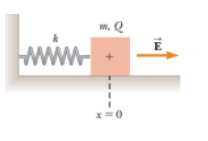A block having mass m and charge + Q is connected to an insulating spring having a force constant k . The block lies on a frictionless, insulating, horizontal track, and the system is immersed in a uniform electric field of magnitude E directed as shown in Figure P24.6. The block is released from rest when the spring is unstretched (at x = 0). We wish to show that the ensuing motion of the block is simple harmonic. (a) Consider the system of the block, the spring, and the electric field. Is this system isolated or nonisolated? (b) What kinds of potential energy exist within this system? (c) Call the initial configuration of the system that existing just as the block is released from rest. The final configuration is when the block momentarily comes to rest again. What is the value of x when the block comes to rest momentarily? (d) At some value of x we will call x = x 0 , the block has zero net force on it. What analysis model describes the particle in this situation? (c) What is the value of x 0 ? (f) Define a new coordinate system x ′ such that x ′ = x − x 0 . Show that x ′ satisfies a differential equation for

Trending now
This is a popular solution!
Step by step
Solved in 2 steps


